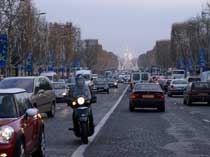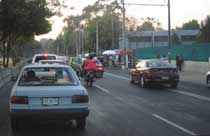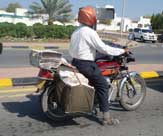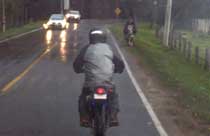Staying Safe on the Road Motorcycling
Many people across the globe get around on motorcycles, scooters, or mopeds. These vehicles cost less to buy and operate than cars. They can be used year-round, especially in warmer climates. However, the motorcycle and its cousins are much trickier to drive and control than cars or bicycles. The driver must balance on two wheels at a relatively fast pace, while open to all sorts of air and road conditions.
|
|
Photo courtesy of Fabio Corbellini Motorcycles are a great way to see the countryside. Drivers should wear proper safety gear at all times. |
In the United States and Europe, people use motorcycles chiefly for recreational riding. But in Southeast Asia and China, the motorcycle or one of its relatives—the scooter or moped—is often the family vehicle. Adults and adolescents use them for basic transportation. Children ride to school on the back of them. As a result, motorcycles feature prominently in the alarming road-accident statistics from that part of the world, relating particularly to casualties among young people.
|
In many parts of the world, such as Rumbai, Pekanbaru, Indonesia, children travel with adults on motorcycles and similar vehicles. Both passenger and driver should wear helmets and other safety gear, and passengers should hold on with both hands. |
A motorcycle-pulled taxi is an easy way to get around a city. The motorcycle driver is clearly safety-conscious—he is wearing a helmet. |
The smaller size of motorcycles makes them less visible to the other, larger vehicles sharing the roads—cars, trucks, and buses. With no protective shell and no seat belts to hold a rider or passenger in place, a motorcyclist is much more vulnerable to injuries from a collision. In such an event, the rider can get thrown off the motorcycle and into the road by the force of the collision or can get pinned under the bike. All of these scenarios can lead to significant and possibly fatal injuries.
So how do you stay safe on a motorcycle or one of its cousins, whether driving or riding along?
Staying Safe on Two Wheels
Many countries require a motorcyclist to take a course on motorcycle riding in order to obtain a motorcycle driving license. This kind of class teaches riders how to use the vehicle, how to spot the dangers on the road, and how to deal with them. In most places, motorcycles must follow the same rules of the road as cars.
The keys to motorcycle safety are protection and visibility. Because the motorcycle is an open vehicle, the rider must provide himself or herself with a shell. This starts with a helmet that fits properly and meets safety standards. Wearing a helmet is the single most effective way for the rider or passenger to reduce the risk of brain injury and increase the odds of surviving a collision. Unfortunately, many places do not have laws making helmets mandatory, and so many people choose not to wear them. Besides protecting a rider’s head in a collision, helmets provide another safety advantage: a light-colored helmet increases a motorcyclist’s visibility on the road.
|
Motorcycle safety gear includes a helmet with a visor and face protection, a sturdy jumpsuit, and gloves. |
Motorcycles are smaller than most other vehicles on the road, making them harder for other drivers to see. |
|
|
Helmets, boots, and leather jackets help protect motorcyclists from debris that may fly up from the road. Although this gear can be hot to wear, especially for these riders in Oman, the concern for personal safety outweighs personal comfort. |
This motorcyclist on the Champs Elysees in Paris, France, is providing a good example of what not to do. When riding in traffic, motorcyclists should stay in the correct lane and should not ride on the lane line, especially in two-way traffic. |
Other protective gear is equally important. A visor on the helmet keeps dirt, bugs, and road debris from the driver’s eyes and face. Goggles or sunglasses can also provide cover for the eyes. Padded clothing—jackets, trousers, boots, and gloves—protects the driver and passenger from road debris as well as abrasions in the event of a collision.
A major cause of motorcycle collisions is the failure of drivers of larger motor vehicles to see motorcycles. The smaller size of motorcycles, darkness, heavy traffic, blocked vision, or simple carelessness makes motorcycles harder to see on the road. Riders can increase visibility in a number of ways. Motorcycles may come equipped with many of the same basic safety features as automobiles: headlights, taillights, brake lights, and signal lights. These lights should be used. In fact, many countries now require daytime running lights on motorcycles to make the bikes more visible. Proper use of signal lights alerts drivers of larger vehicles to the cyclist’s intentions. Bright colors and reflective strips on the cyclist’s clothing increase the overall visibility.
Motorcyclists should ride in such a way as to remain as visible as possible to all vehicles. Most car-motorcycle accidents occur at intersections, where visibility is reduced by cars turning from different directions. Motorcycles must stay a good distance from other vehicles, and out of blind spots as much as possible. The smaller size and greater agility of motorcycles makes riders able to weave in and out of traffic or ride between lanes on the highway. However tempting, especially in a traffic jam, this is a dangerous, and in some places illegal, practice.
The even-smaller scooters and mopeds may be even less visible to motorists. It is therefore even more important that drivers of these vehicles obey the rules of the road.
Excessive speed causes many motorcycle crashes. One reason: A motorcycle’s alignment can be affected by high speed. This can then cause the front wheel and steering mechanism to wobble. Wobble can also occur if the motorcycle’s wheels are out of balance or for other mechanical reasons. The rider has less control if the unexpected occurs and he or she needs to brake suddenly or steer around something. And, of course, the higher the speed at the time of a collision, the harder the impact when the rider hits the ground, a guardrail, or another vehicle.
|
Even in traffic that is traveling in one direction, riding between lanes is very risky. |
Carrying cargo on a motorcycle can be tricky. The weight of the items must be balanced, to keep the rider upright. |
Bad weather makes motorcycle riding that much more difficult. Conditions that are slippery on four wheels is even trickier to negotiate |
Motorcycles are very vulnerable to unsafe road conditions. A motorcycle that hits debris or gravel in the road can be thrown off balance. Conversely, debris or gravel can be kicked up by other vehicles and can strike the rider. Unevenness in the pavement and potholes can catch the wheels and cause the rider to lose balance or flip. Slippery roads, which are tricky for cars and trucks, are that much more dangerous to two-wheeled vehicles. The small wheels of scooters make them even more vulnerable to ruts and other defects in the road.
Many motorcycles are made for only one rider. Riders should not carry a passenger unless the motorcycle is equipped with a passenger seat and foot pegs (footrests). Riding with a passenger changes the way the motorcycle or scooter handles. It requires even more skill than riding alone and is for experienced riders only.
A very high proportion of motorcycle crashes result from driving while under the influence of alcohol or drugs. The effects of these substances are even more significant for motorcyclists than for car drivers because of the greater skill and coordination needed to operate a bike. Also, of course, drugs or alcohol may release inhibitions, making a rider more likely to take risks, such as speeding or racing. The consequences on a motorcycle can be disastrous.
|
|
|
 |
Digging DeeperFind out more about |
|
|
|
This content has been re-published with permission from SEED. Copyright © 2025 Schlumberger Excellence in Education Development (SEED), Inc.




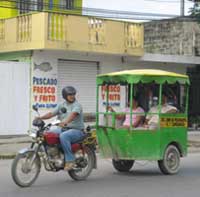

.jpg?n=3446)

